Nangiarkoothu / Nangiar Koothu : A 1500-Year Old Traditional Solo Sanskrit Dance & Theatre Art Form from Kerala – History, Types, and the Epic Tale of Poothana Moksham from Life of Lord Krishna, A Spectacular Nangiar Koothu Performance (Updated)
– dance form with a mesmerizing blend of hand gestures, facial expressions, & body movements
| CasualWalker’s Rating for Poothana Moksham – Nangiarkoothu by Sri Jayalakshmi : | |

9.9 – Great / Excellent
|
Nangiarkoothu / Nangiar Koothu, also known as Nangiaramma Koothu, is a distinguished Sanskrit dance-theatre form from Kerala with a rich heritage spanning at least 1500 years. Historically, it was exclusively performed in temple settings known as Kootahambalams.
In contrast to Koodiyattam, a Sanskrit drama involving both male and female actors, Nangiarkoothu stands out as a solo performance tradition, traditionally enacted by women from the Ambalavasi Nambiar community of Kerala, known as Nangyaramma.



The narratives for Nangiarkoothu performances are drawn from the revered text Sri Krishna Charitam, narrating the captivating life of Lord Krishna. During these performances, the actress skillfully portrays the intricate tales of Lord Krishna through a mesmerizing blend of hand gestures, facial expressions, and body movements, accompanied by the resonant rhythms of the mizhavu, a traditional pot drum.

Nangiarkoothu is predominantly characterized by Abhinaya, the expressive aspect of dance, with minimal emphasis on nritta, or pure dance elements. It comprises two significant segments: Nirvahanam, a retrospective solo act recounting past events, and the play itself, featuring dialogues and multiple characters.

Throughout the performance, a single actress adeptly assumes various roles within the narrative, bringing the story to life through a meticulously structured system of hand gestures, emotive expressions, verse recitations, and unique stage techniques. Accompanying the performers are skilled artists playing the Mizhavu, a copper pot drum, and hollow cymbals, enhancing the immersive experience for the audience.

Origins of Nangiar Koothu
The inception of Nangiarkoothu holds a fascinating history. It is said that King Kulashekara Varman, impressed by the talents of a Nangiar actress, married her. However, some segments of society viewed her children as outcasts. Upon learning of this injustice, the king granted them special rights to perform Koothu, a traditional art form, in temples across his kingdom. He even commissioned the writing of the text “Sri Krishnacharitam” for the Nangiars to perform. To support these performances, tax-free properties were allocated. Over time, the community gained recognition, and efforts were made to grant equal status to Nangiars. The performance typically spans two parts, each lasting around one and a half hours.



Nangiarkoothu Major Segments
Nangiarkoothu’s performances are often considered challenging for uninformed viewers to comprehend. With over 217 slokas intricately woven into its narrative, a full presentation can take approximately 30-40 days to complete. Some of the most renowned performances, such as Putana Moksham, are showcased by Nangiarkoothu artists across Kerala.
Purappad
The Purappad marks the entrance of a significant character onto the stage. In Nangiarkoothu, this ritual is steeped in tradition, symbolizing the arrival of Subhadra’s maid, Kalpalithika, who serves as the storyteller. In presentations spanning multiple years, Purappad is performed annually. Upon its conclusion, the actor, adorned in costume, pays homage to the deity within the temple sanctum.
Sankshepa
Sankshepa involves narrating the essence of the story through gestures and recalling previous events to set the stage for the performance. The actor, seated on a stool, extends her left hand, touching it thrice with her right hand at her elbow, forearm, and fingertips in succession.
Anukrama
Anukrama involves moving backward through a series of incidents by posing questions through gestures, accompanied by the inquiry, “How was it that this happened?” This technique connects the characters to their backstory, adding depth to their portrayal.
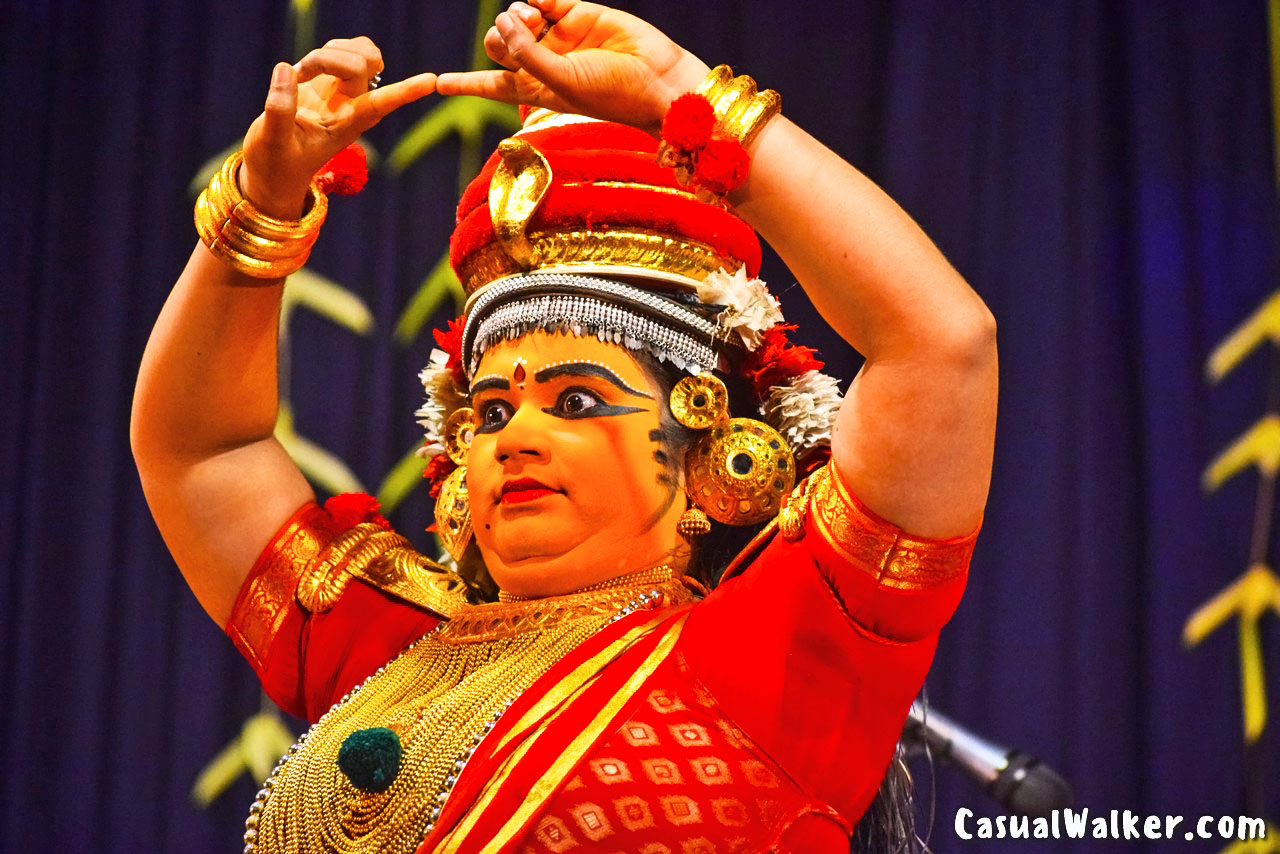
Nirvahanam
Nirvahanam is a unique stage technique where a character recounts past events, often their own story or flashback, setting the context for their appearance on stage. In Nangiarkoothu, this technique is elevated as a single character visually recites a detailed story, resembling more of a storytelling art than conventional theatre.
Pakarnattam
Pakarnattam, translating to “transpose and dance,” involves role-play where the actor transitions between roles, changing position and gesturing to denote character changes and dialogue exchanges.
Mudras
Both Koodiyattam and Nangiarkoothu employ an extensive vocabulary of mudras, encompassing proper nouns, common nouns, verbs, and prepositions (vibhakti in Sanskrit). The meaning of a mudra varies depending on the context of its usage.
Swara
Swara refers to the melodic recitation of slokas, interchangeably called swara or ragas. Each sloka is taught and recited in a specific raga, reflecting the emotional content, or “bhava,” of the verse.


Poothana Moksham – Nangiar Koothu Performance by Sri. Jayalakshmi .M
The Nangiarkoothu performance of “Poothana Moksham” by esteemed artist Sri. Jayalakshmi .M showcases a captivating portrayal of this ancient tale. Through her splendid and marvelous performance, Jayalakshmi exemplifies the rich tradition and storytelling excellence inherent in Nangiarkoothu. With exquisite mastery, Jayalakshmi brings to life the narrative of “Poothana Moksham,” captivating audiences with her portrayal of the demoness Puthana’s encounter with the divine infant Krishna. Through the medium of Nangiarkoothu, she skillfully evokes the essence of the story, delving into the depths of emotions and capturing the essence of each character’s journey.

Jayalakshmi’s performance resonates with the essence of “rasa,” the aesthetic essence that encapsulates the emotional experience of the audience. Through her expressive gestures, nuanced facial expressions, and evocative storytelling, she creates a profound emotional connection with the spectators, immersing them in the divine drama unfolding before their eyes.

Poothana Moksham : The Salvation of Puthana
Poothana Moksham is a significant tale surrounding the childhood of Lord Krishna. It narrates the encounter between Krishna, an infant deity, and Puthana, a demoness sent by the malevolent King Kamsa to eliminate him.


According to the legend, Kamsa, fearful of a prophecy predicting his demise at the hands of Krishna, dispatches Puthana to execute all newborns in the vicinity. Disguised as a beautiful woman, Puthana infiltrates the homes of innocent families, posing as a caretaker before revealing her true form and administering her lethal poison.


In the narrative, Puthana approaches the infant Krishna, intending to nurse him with her toxic milk. However, Krishna, aware of her nefarious intentions, willingly suckles from her breasts, simultaneously extracting her life force and freeing her soul from the cycle of rebirth – hence the term “Moksham,” signifying liberation.

Poothana Moksham symbolizes the triumph of good over evil and the divine protection afforded to devotees of Lord Krishna. It illustrates Krishna’s divine nature and his ability to thwart the schemes of malevolent forces, even as an infant.

This tale is often depicted in various forms of art, including classical dance-dramas like Koodiyattam and Nangiarkoothu, as well as in paintings, sculptures, and devotional literature, reflecting its enduring significance in Hindu culture and spirituality.







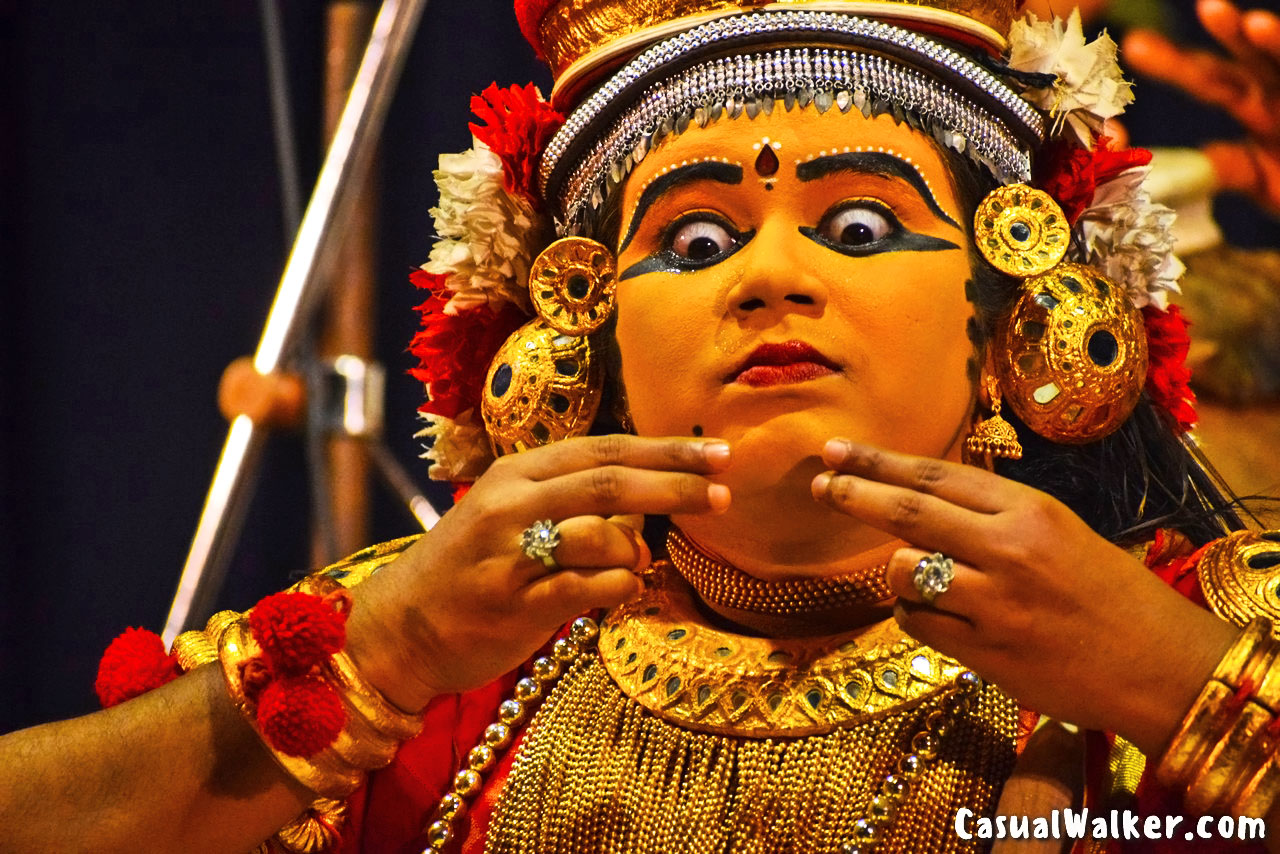




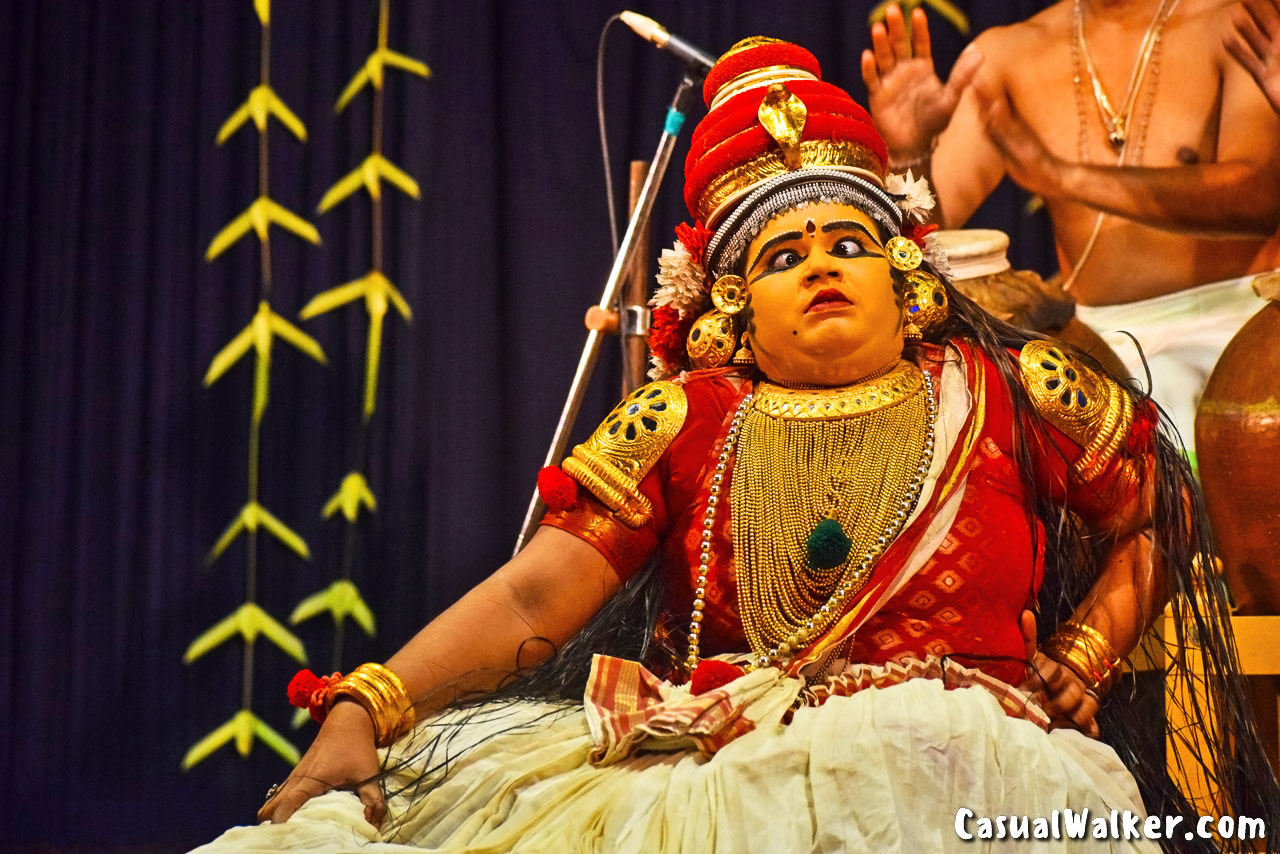




Also, check our Similar Photo Stories on Dance & Culture :
Koothu Kottaai – Grand Folk Arts Show Of Tamil Nadu (Part 1)



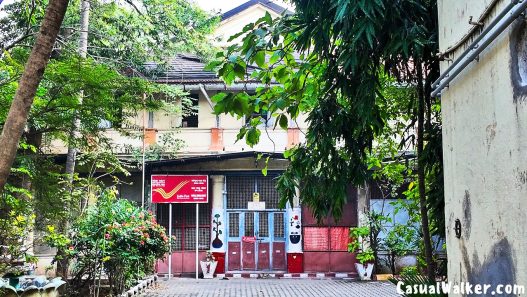















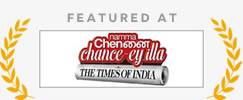













61y0k5
I’ve read some good stuff here. Definitely worth bookmarking for revisiting. I surprise how much effort you put to create such a fantastic informative website.
d45b88
You should take part in a contest for one of the best blogs on the web. I will recommend this site!
You are my inspiration , I have few web logs and often run out from to brand.
Whoa! This blog looks just like my old one! It’s on a completely different topic but it has pretty much the same layout and design. Excellent choice of colors!
You have mentioned very interesting points! ps decent website .
There’s noticeably a bundle to know about this. I assume you made certain nice factors in options also.
I am also commenting to make you be aware of of the outstanding discovery my cousin’s child gained reading your web site. She figured out a wide variety of issues, which included how it is like to possess an ideal coaching mood to let others really easily fully understand certain hard to do subject matter. You really surpassed people’s expected results. Many thanks for supplying the priceless, safe, revealing and even cool guidance on that topic to Janet.
https://t.me/s/officials_pokerdom/3917
https://t.me/s/IZZI_officials
Strongly written
Spot on with this write-up, I truly assume this web site needs much more consideration. I’ll in all probability be again to read rather more, thanks for that info.
Appreciate the insight
N8casino is my go-to spot for some online gambling fun. They have a wide variety of games and the payouts are pretty decent too. Check out them from n8casino if you are looking for a good time.
After research just a few of the weblog posts on your website now, and I truly like your manner of blogging. I bookmarked it to my bookmark web site listing and might be checking back soon. Pls check out my web page as properly and let me know what you think.
I’m not sure where you are getting your info, but good topic. I needs to spend some time learning more or understanding more. Thanks for magnificent info I was looking for this information for my mission.
Das Bonusgeld gehört bei vielen Sportwettenanbietern zum Willkommenspaket
fest dazu. Hier seid ihr dann zuerst damit beschäftigt, die Bonussumme freizuspielen und
dabei auf die entsprechenden Bedingungen zu achten. Denn in diesem Fall ist sehr
oft die abgeschlossene Registrierung Voraussetzung, um den Wettanbieter Bonus ohne Einzahlung 2021 zu erhalten. Sehr oft erhalten Neukunden bei ihrem
gewählten Buchmacher einen sattenSportwetten Ersteinzahlungsbonus,
Gratiswetten oder eine echte Freiwette mit Cashback.
Ein großartiger Weg, um im Online Casino durchzustarten,
ist ein Online Casino Bonus, äußerst beliebt sind 50 Freispiele ohne Einzahlung für Novoline.
Ein äußerst beliebter und begehrter Bonus bei Online Casinos sind 50 Freispiele ohne Einzahlung.
Bei einigen der empfohlenen Casinos erhältst du Free Spins zum Einzahlungsbonus
extra dazu. 50 Freispiele ohne Einzahlung stellen bereits ein interessantes Bonusangebot dar.
Wenn du also alle Freispiele nutzen möchtest, solltest du dich täglich
einloggen! Die Gewinne aus den Free Spins werden deinem Konto jedoch oft direkt als Echtgeld gutgeschrieben und
können jederzeit ausgezahlt werden.
Bonusgeld ohne Einzahlung ist eine verbreitete Variante des No Deposit Bonus.
Normalerweise variiert die Anzahl der Freispiele zwischen 10 und 100.
So kann er das Casino selbst bewerten, verschiedene Glücksspielaktivitäten ausprobieren und sogar die ersten Auszahlungen erhalten, ohne sein eigenes Geld
zu riskieren.
References:
https://online-spielhallen.de/ihr-ultimativer-leitfaden-zum-1go-casino-promo-code/
Steigern Sie Ihre Gewinnchancen, indem Sie unter den besten Bedingungen spielen. Möchten Sie zum ersten Mal Poker um echtes Geld spielen, fühlen sich aber noch nicht bereit, sich mit
anderen Spielern am Tisch zu messen? Egal, ob Sie gelegentlich eine
Runde spielen oder sich in Turnieren beweisen möchten. Für viele Spieler spielen auch die Gewinnchancen eine wichtige Rolle bei der Wahl ihres Casino-Spiels.
Spieler können etwa die Anzahl der Pin-Reihen wählen, das Risiko einstellen und das
Spiel mit mehreren Bällen im Autoplay-Modus spielen.
Ein gutes Live Casino zeichnet sich durch eine breite
Spielauswahl, faire Setzlimits und qualifizierte Croupiers aus.
Diese Spiele bieten nicht nur spannende Themen, sondern auch attraktive Gewinnmöglichkeiten. In Deutschland
sind online slot aufgrund ihrer Vielfalt und hohen Gewinnchancen äußerst beliebt.
Online Slots sind das Herzstück vieler Online Casinos und bieten eine unglaubliche Vielfalt an Themen und Spielmechaniken.
Im Jahr 2025 stehen diese Casinos an der Spitze des Online-Glücksspiels
und bieten eine erstklassige Erfahrung für alle Spieler.
Diese Seiten bieten Spiele mit hohen RTPs (Return to Player), was bedeutet, dass Spieler eine höhere
Chance auf Gewinne haben, besonders bei Online Casino Echtgeld Spielen. Diese Casinos bieten Spielern bessere Gewinnchancen und ein transparentes Spielumfeld, was sie besonders für Echtgeld-Spieler attraktiv
macht. Spiele mit einer hohen Auszahlungsquote (RTP) sind bei Spielern besonders beliebt, da sie bessere Gewinnchancen in einem Echtgeld Casino bieten.
References:
https://online-spielhallen.de/top-9-online-casinos-in-deutschland-2025/
https://t.me/s/iGaming_live/4873
Auch große Pokerturniere, die hier regelmäßig
stattfinden und bekannte Pokerstars nach Enschede ziehen sind ein Publikumsmagnet, für das sich der Ausflug über die Grenze definitiv lohnt.
An vielen Wochenenden findet abends nämlich Livemusik statt.
Für alle, die zu später Stunde noch Hunger bekommen,
gibt es im Saal diverse niederländische Snacks, die direkt an der Bar bestellt werden können. Auch wenn Glücksspiele
nicht so dein Ding sind, lohnt sich ein Abendessen hier, es ist
einfach ein wahres Erlebnis! Die Speisekarte wechselt regelmäßig und bietet
neben diversen Klassikern auch wechselnde saisonale
Gerichte und Spezialitäten des Chefkochs.
Das Kleine Spiel im Casino Bremen wird hingegen von rund 130 Spielautomaten gestellt und somit
gut abgedeckt. Auch wenn das Casino Bremen eher zu den kleineren Glücksspieltempeln zu zählen ist,
ist es dennoch eine der schönsten Spielbanken Deutschlands.
Zudem hat die schmucke Spielbank, die zur Westspiel Gruppe gehört, noch zahlreiche Events in der Hinterhand.
References:
https://online-spielhallen.de/joo-casino-deutschland-ihr-umfassender-leitfaden/
I cherished up to you will obtain carried out right here. The cartoon is attractive, your authored material stylish. nonetheless, you command get got an shakiness over that you would like be delivering the following. ill definitely come further earlier once more as precisely the similar nearly a lot incessantly inside case you defend this hike.
It is actually a nice and useful piece of info. I’m satisfied that you simply shared this helpful info with us. Please stay us informed like this. Thanks for sharing.
If it is a deposit bonus, you will be invited to make a
deposit. If it is a free bonus, coupon will be redeemed to your account.
Wagering is 30x bonus + deposit, 20x for the free spins.
Each bonus requires a $20 minimum deposit and can be redeemed once only.
Australian players at Ozwin may get the 3 for 2 gifts, but they must have
a real-funds account. These points can be exchanged
in Ozwin’s virtual store for deposit bonuses, free spins, or free chips.
This feature-rich experience lets users complete in-casino missions, earn points, and redeem exclusive bonuses.
This function is not hidden or anonymized, making it possible for
all players to observe how often payouts occur, on which games, and at what value thresholds.
References:
https://blackcoin.co/thrill-awaits-at-lucky-ones-casino/
They also can double your bankroll and allow you to take some free spins on a specific slot games.
You can secure a casino bonus by tapping PLAY NOW in this guide, signing up for account,
making a deposit with your preferred payment method
and fulfilling any other wagering requirements as dictated by the terms and conditions.
Also make sure you take advantage of multiple casino apps to compare offers and maximize your total bonus value.
Winnings from these additional spins usually
convert to bonus funds with playthrough requirements.
If you want an additional layer of protection and a piece of mind when enjoying
casino games, you should do the same. The interesting thing about gambling in casinos is that
the problems are always around the corner,
even in the platforms that seem flawless.
What you are looking for if you want a safe gaming experience online is a platform that
operates under the latest SSL-encryption technologies.
The licensing regulators thoroughly check this when they issue a license
to a specific online casino. Outside of the part
where you’re having fun in an online casino, the platforms security is vital.
If you aren’t sure what a decent gaming selection looks like, imagine at least a
thousand games from some of the leading developers in the industry.
At Gambtopia.com, you’ll find a comprehensive overview
of everything worth knowing about online casinos. Most
Australian casinos offer built-in tools like deposit
limits and session reminders to support responsible gambling.
The excitement of playing at real money casinos is
undeniable, but staying safe while you enjoy the action is
just as important. For Aussie players who stick around,
VIP and loyalty schemes offer ongoing rewards that go beyond basic bonuses.
These games offer a refreshing break from the norm, ideal for players who want
to mix things up and explore a new kind of excitement beyond the standard tables and reels.
References:
https://blackcoin.co/ultimate-guide-to-online-casinos/
DingDing upst-airs yellow House Free parking
A period of significant growth has followed, including the redevelopment of the former Macquarie Point railyards, Parliament Square, and new hotel developments throughout the city.
While Hobart was isolated, it also contained the not insignificant Electrolytic Zinc Company which was essential for ammunition production. Later that
year, along with the military, settlers and convicts from
the abandoned Port Phillip settlement, the camp
at Risdon Cove was moved by Captain David Collins to
a better location at the present site of Hobart at
Sullivans Cove. Despite the rise in migration from Asia
and other non-English speaking regions, Hobart’s population is predominantly ethnically Anglo-Celtic and has
the highest percentage of Australian-born residents among Australia’s capital cities.
References:
https://blackcoin.co/33_best-high-roller-slots_rewrite_1/
Software providers include Pragmatic Play, Play’n GO, NetEnt,
Microgaming, Evolution, and Yggdrasil. Current details appear on the
bonus page of the official site. VIP benefits include tiered cashback,
higher withdrawal limits, and personal support.
Lukki Casino Australia is fully mobile-optimized, allowing
instant access from any smartphone or tablet.
If problems persist, reach out to customer support for assistance.
– Contact Lukki’s support team for verification.✔ Slow Loading?
Just started playing Lukki and it’s great so
far. Lukki Exchange has been an incredible platform with a large and growing user base, and I’ve
always wanted to be a part of it. They are very good at what they do and were fast to recover any issues I’ve had during my experience.
Im very blown away with the customer support team.
And withdrawals are fast if your account is verified.
References:
https://blackcoin.co/a-big-candy-casino-au-real-money-pokies-fast-payouts-in-au/
Enjoy personalised hosts, private entrances, luxurious interiors, and tailored dining – all designed for
elite gaming. Earn and redeem points across gaming, hotels,
restaurants, and more — online and on-site.
From world-class Japanese cuisine to relaxed al fresco dining, there’s something for every taste and budget.
I am an individual taxpayer. Secure access message has been added to protect from
phishing websites. What are the Login service improvements on the
new portal? The e-Filing vault option provides multi-factor authentication for login and password reset.
The fully licensed casino offers hundreds of pokies (slots), classic table
games such as blackjack, roulette, and baccarat, as well as exclusive VIP salons.
It combines high-end casino entertainment, 5-star accommodation,
live performances, and premium hospitality in one breathtaking location. With
critically acclaimed restaurants brought to you by the world’s culinary elite,
Crown Perth offers dining at its finest. Indulge in a hotel breakfast buffet or treat yourself to a hotel fine dining experience.
The Crown Perth is a contemporary pyramid-style hotel located near
the magnificent Swan River. The Crown Metropol
is a first-class luxury hotel with spectacular city views.
References:
https://blackcoin.co/online-slots/
This reputable casino offers a wide range of
exciting games, from classic slots to modern video poker
and roulette, all tailored to enhance your enjoyment.
Join Wolf winner today and claim an incredible 250% Welcome
Bonus on your first deposit, plus Free Spins to enhance your gaming experience!
Especially when mobile games are involved because a few reviewers hate being tied down.
If you are tired of complicated mechanics and want to play 3-reel
or 5-reel pokies with burning fruits and sevens of the reels,
here are a few titles you can experience. Due to the diversity of online pokies and providers
at Wolf Winner, Australians can play for real money, placing bets in AUD or crypto.
The minimum deposit is AUD 10, though most bonuses require a minimum of AUD 20.
Its gaming library hosts 1000+ games from Australian-friendly providers like BGaming, Yggdrasil, and Mascot.
References:
https://blackcoin.co/las-vegas-a-comprehensive-guide/
us online casinos that accept paypal
References:
popijob.com
us poker sites that accept paypal
References:
https://aviempnet.com
online slots paypal
References:
systronics.co.kr
online casinos that accept paypal
References:
https://www.tokai-job.com/employer/best-real-money-poker-sites-for-2025-real-money-online-poker-for-usa/
Great site! I am loving it!! Will be back later to read some more. I am bookmarking your feeds also
Yo, Epicwingaming! Been hitting your site lately. Gotta say, the slots are pretty 🔥. Just wish there were more free spins, you know? But overall, good vibes! Check out epicwingaming.
I have been absent for some time, but now I remember why I used to love this blog. Thank you, I¦ll try and check back more frequently. How frequently you update your web site?
paypal casino android
References:
https://career.abuissa.com/employer/best-australian-casino-sites-2025-aussie-online-casinos/
online slot machines paypal
References:
https://kabayan.kr/bbs/board.php?bo_table=free&wr_id=149
You are my inhalation, I have few blogs and rarely run out from brand :). “The soul that is within me no man can degrade.” by Frederick Douglas.
优质成人平台 为成熟观众提供优质内容。探索 经过验证的成人网站 以确保质量和隐私。
Take a look at my blog … Download Windows 11 Cracked
Real nice layout and superb written content, very little else we require : D.